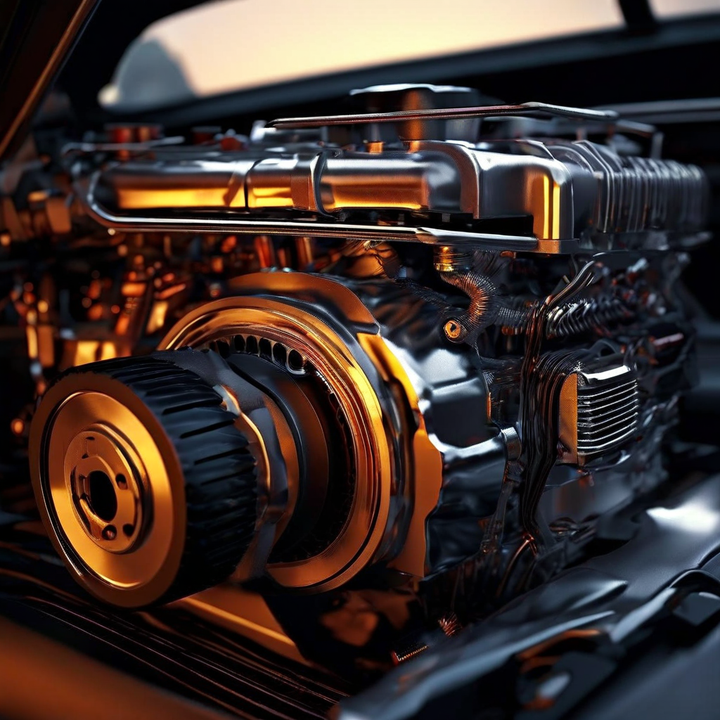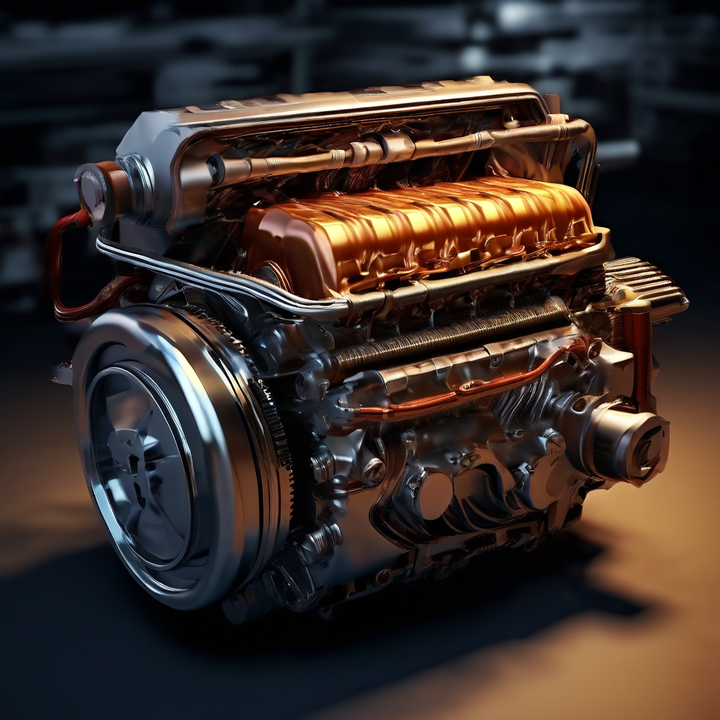


The diagnostic trouble code (DTC) P03A4 indicates that the engine control module (ECM) has detected low cylinder pressure in cylinder #2 of the engine. This code is related to the engine's combustion monitoring system, which uses sensors to measure the pressure inside each cylinder during the combustion process.
Before we dive into the nitty-gritty details, let's first grasp the significance of this code. The P03A4 code is a specific diagnostic trouble code (DTC) that relates to the pressure levels within cylinder 2 of your engine. This code is typically triggered when the engine control module (ECM) detects abnormally low pressure readings from the glow plug or pressure sensor associated with that particular cylinder.
Now, let's explore the potential culprits that could be responsible for triggering this code. As with any diagnostic process, it's essential to approach the issue systematically and consider all possible scenarios.
| Common Issues | Detailed Explanation |
|---|---|
| Faulty Glow Plug/Pressure Sensor | The glow plug acts as a pressure sensor, and if it fails, it can provide incorrect pressure readings to the ECM. This inaccurate data can lead to the ECM mistakenly interpreting the pressure in cylinder 2 as being too low, triggering the P03A4 code. |
| Leaking Injector or Injector Problem | A leaking fuel injector for cylinder 2 can cause an imbalance in the air/fuel mixture. If not enough fuel is being delivered to the cylinder, the resulting mixture may not be compressed properly, leading to low cylinder pressure readings and the P03A4 code. |
| Low Compression in Cylinder 2 | Worn piston rings, valves, or other internal engine components specific to cylinder 2 can lead to a loss of compression within that cylinder. When compression is low, the air/fuel mixture cannot be adequately compressed, resulting in low pressure readings and the P03A4 code being set. |
| Restriction in the Intake/Exhaust System | A restriction in the intake or exhaust system for cylinder 2, such as carbon buildup or a blockage, can restrict airflow and prevent the proper amount of air from entering or exiting the cylinder. This restriction can cause low pressure readings, triggering the P03A4 code. |
Mechanical Timing Issues: If the camshaft timing is off or the valves are not opening and closing at the correct intervals for cylinder 2, it can lead to low cylinder pressure and trigger the P03A4 code.
Exhaust Leak: A leak in the exhaust system specific to cylinder 2 can cause a loss of pressure and result in low cylinder pressure readings, setting off the P03A4 code.
Faulty ECM or Wiring: In rare cases, a faulty engine control module (ECM) or wiring issue related to the cylinder pressure sensor circuit for cylinder 2 can cause incorrect readings and trigger the P03A4 code.
As a mechanic, I always emphasize the importance of a thorough diagnostic process. When faced with the P03A4 code, here are the steps I typically follow:
Check for Related Codes: I start by checking for any other codes related to cylinder 2, such as misfire codes, injector circuit codes, or camshaft position sensor codes. These additional codes can provide valuable insights and help narrow down the root cause.
Perform a Compression Test: A compression test is a crucial diagnostic tool that can help identify if there's a problem with low compression in cylinder 2. This test involves measuring the compression pressure in each cylinder and comparing the results to the manufacturer's specifications.
| Compression Test Results | Interpretation | |--------------------------|-----------------| | Cylinder 2 compression significantly lower than other cylinders | Indicates a potential issue with low compression in cylinder 2, such as worn piston rings, valves, or other internal components. | | All cylinders have low compression | Suggests a more widespread issue, such as a problem with the timing chain or camshaft. | | Compression readings within specifications | Rules out low compression as the cause of the P03A4 code. |
Monitor Cylinder Pressure Data: Using a scan tool, I monitor the cylinder pressure data for cylinder 2 at idle and under load conditions. This real-time data can help pinpoint any abnormalities or deviations from the expected pressure readings.
At idle, the cylinder pressure should be relatively consistent across all cylinders.
Under load, the cylinder pressure should increase proportionally for all cylinders.
Significant deviations in cylinder 2 pressure readings compared to other cylinders can indicate the root cause of the P03A4 code.
Inspect Electrical Connectors: I visually inspect the electrical connectors for the glow plug/pressure sensor to ensure there are no loose connections, corrosion, or damage that could be causing intermittent or inaccurate readings.
Check for Intake/Exhaust Leaks or Restrictions: I carefully inspect the intake and exhaust systems for cylinder 2, looking for any signs of leaks, restrictions, or blockages that could be impeding airflow and causing low pressure readings.
| Inspection Findings | Potential Causes | |---------------------|-------------------| | Intake leak or restriction | Carbon buildup, damaged intake components, or air filter restriction. | | Exhaust leak or restriction | Exhaust manifold leak, catalytic converter restriction, or muffler blockage. |
Perform a Cylinder Leakdown Test: If low compression is suspected, a cylinder leakdown test can help pinpoint the specific area where compression is being lost, such as piston rings, valves, or cylinder head gasket.
Once the root cause has been identified through the diagnostic process, it's time to take the necessary repair steps. Here are some common repair procedures for the P03A4 code:
Replace the Glow Plug/Pressure Sensor
Replace the Injector
Repair Intake/Exhaust Leaks or Remove Restrictions
Internal Engine Repairs (based on cylinder leakdown test results)
Replace piston rings
Valve repair or replacement
Cylinder head gasket replacement
Timing chain or camshaft repair/replacement
While repairs are essential, prevention is equally important to avoid future occurrences of the P03A4 code. Here are some tips to help prevent this issue:
Follow Recommended Service Intervals
Adhere to the manufacturer's recommended service intervals for components like glow plugs, injectors, air filters, and timing belt/chain replacement.
Use High-Quality Fuel and Engine Oil
Using high-quality fuel and engine oil can help maintain optimal engine performance and prevent excessive wear or buildup that could lead to issues like low cylinder pressure.
Avoid Excessive Idling or High Load Conditions
Excessive idling or prolonged high-load conditions can put additional stress on the engine and accelerate wear, potentially leading to issues like low cylinder pressure.
Fix Intake/Exhaust Leaks Promptly
If you notice any intake or exhaust leaks, it's crucial to address them promptly to prevent further damage or issues like low cylinder pressure.
Regular Engine Maintenance
Perform regular engine maintenance tasks, such as valve adjustments, spark plug replacements, and fuel system cleanings, to ensure optimal engine performance and prevent potential issues.
The cost of repairs associated with the P03A4 code can vary significantly depending on the root cause. Here's a general breakdown of potential costs:
| Repair | Estimated Cost Range |
|---|---|
| Glow Plug/Pressure Sensor Replacement | $100 - $300 |
| Injector Replacement | $300 - $600 |
| Intake/Exhaust Repairs | $200 - $500 |
| Internal Engine Repairs (Rings/Valves) | $1,000 - $3,000+ |
| Timing Chain/Camshaft Repair | $800 - $2,000+ |
| Cylinder Head Gasket Replacement | $1,000 - $2,500+ |
It's important to note that these costs are estimates and can vary based on factors such as the make and model of your vehicle, labor rates in your area, and the complexity of the repair. Additionally, proper diagnosis is crucial to accurately identify the root cause and avoid unnecessary part replacements, which can significantly impact the overall cost.
Dealing with the P03A4 code can be a challenging task, but with the right knowledge, diagnostic approach, and attention to detail, it's a hurdle that can be overcome. As a mechanic, I've learned that patience, systematic troubleshooting, and a commitment to finding the root cause are key to successfully resolving such issues.
Remember, regular maintenance, addressing any issues promptly, and following preventive measures can go a long way in avoiding the occurrence of codes like P03A4. If you ever encounter this code or any other diagnostic trouble, don't hesitate to seek the assistance of a qualified mechanic who can accurately diagnose and repair the issue.
Happy motoring, and may your engines run smoothly!
Additional codes like misfire codes (P0300-P0308) for other cylinders, fuel system codes, or camshaft/crankshaft sensor codes may be present. These can help pinpoint the root cause when diagnosed together with P03A4.
Yes, a faulty glow plug that also acts as the cylinder pressure sensor for cylinder 2 can provide incorrect pressure readings, triggering the P03A4 code.
A leaking fuel injector for cylinder 2 can cause an imbalance in the air/fuel mixture, resulting in low cylinder pressure and setting the P03A4 code.
Restrictions or leaks in the intake or exhaust system specific to cylinder 2 can impede proper airflow, causing low pressure readings and the P03A4 code.
Yes, worn piston rings, valves, or other internal components causing low compression in cylinder 2 can result in low pressure readings and the P03A4 code.
A compression test involves measuring the compression pressure in each cylinder using a specialized gauge and comparing the results to the manufacturer's specifications.
A cylinder leakdown test is used to pinpoint the specific area where compression is being lost (rings, valves, head gasket) if low compression is suspected after a compression test. It is needed for further diagnosis.
In rare cases, a faulty engine control module (ECM) or wiring issue related to the cylinder 2 pressure sensor circuit can cause incorrect readings and trigger the P03A4 code.
Following recommended service intervals, using high-quality fuel and oil, avoiding excessive idling/high loads, and promptly fixing intake/exhaust leaks can help prevent issues like low cylinder pressure.
Repair costs can range from $100-300 for a sensor/injector replacement to $1,000-3,000+ for internal engine repairs like rings, valves, or a cylinder head gasket replacement.

Miguel started tinkering with car radios as a teenager, fascinated by the intricate dance of wires and circuits. This passion led him to pursue a career as an automotive electrician. For the past 10 years, Miguel has tackled everything from flickering headlights to mysterious electrical gremlins. He thrives on troubleshooting electrical problems and enjoys sharing his knowledge to empower car owners to understand their vehicles better.



